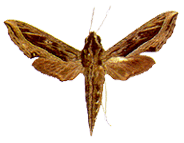|
Hippotion velox Fabricius
Sphinx
velox Fabricius, 1793, Ent. Syst., 3: 378.
Hippotion velox Fabricius; Rothschild & Jordan, 1903: 749.
|

Hippotion velox ♂
(.83 natural size)
|
Diagnosis. The multiple postmedial of the forewing has a more sinuous
course than in other Hippotion and Theretra taxa. The dark discal spot has
a pale halo; there are two pale streaks along the veins subapically as in
the next species. The abdomen has a row of oblique white flecks
subdorsally; in celerio they are straight. No other Bornean species in the
group has these white flecks.
Geographical range. Indo-Australian tropics to Fiji and New Caledonia.
Habitat preference. The species is infrequent in Borneo but has been taken
as high as 2600m on G. Kinabalu.
Biology. Bell & Scott (1937) described the larva. The final instar
occurs in two forms, green and dark. The green form is bright grass green
with obscure yellow dots and a neutral dorsal stripe over the abdominal
segments. The ocellar markings are longitudinally oval, yellow,
irregularly centred with plum colour, situated dorsolaterally on A1. The
horn is violet. The dark form is greyish brown with broken pale yellowish
dorsolateral stripes; the ocellar are markings centred brown, bordered
with pale yellow then black; there are lateral oblique stripes on the
abdominal segments. Similar dimorphism occurs in Java (Dupont & Roepke,
1941).
Recorded host-plants (Bell & Scott, 1937; Dupont & Roepke, 1941;
Pholboon, 1965; Robinson, 1975; Moulds, 1984) are: Alocasia (Araceae);
Brassica (Cruciferae); Ipomoea (Convolvulaceae); Pisonia
(Nyctaginaceae);
Morinda (Rubiaceae).
<<Back
>>Forward <<Return
to Contents page
|

